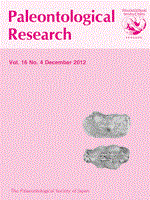Jakarta Bay is a semi-enclosed bay, located on the western side of the northern part of Java Island, Indonesia. This study reports the spatial distribution of recent ostracode assemblages from the top of 19 core samples collected in 1994 and the relationship between the assemblages and environmental factors. This study is the first of the ostracode species of Jakarta Bay, and succeeded in identifying 94 species living there. Ostracodes are common in the East Indian Province. The dominant species found were Keijella carriei Dewi, Hemicytheridea reticulata Kingma, Loxoconcha wrighti Dewi, and Hemicytheridea ornata Mostafawi. Species belonging to the genera Cytherella, Cytherelloidea, Neomonoceratina, and Pistocythereis were also abundant. According to Q-mode cluster analysis, three biofacies (I, II, and III) were recognized, clearly distributed from the inner to the outer parts of the bay. Biofacies I is distributed in the muddy bottoms of the inner to the middle parts of the bay and is composed mainly of K. carriei, L. wrighti, and H. reticulata. Biofacies II is distributed in the muddy bottoms of the outer part of the bay and is characterized by the abundance of H. reticulata, H. ornata, and Cytherella spp. Biofacies III is distributed in the sandy mud bottoms of the outer part of the bay, and is characterized by high-diversity assemblages composed of Atjehella kingmai Keij, Foveoleberis cypraeoides (Brady), Neomonoceratina bataviana (Brady), and Pistocythereis cribriformis (Brady). This study correlated relationships between dominant species and bottom environment factors such as total organic carbon (TOC), total sulfur (TS), total nitrogen (TN), total organic carbon/ total nitrogen ratio (C/N ratio), and total organic carbon/total sulfur ratio (C/S ratio). The results show that K. carriei and L. wrighti are common in areas with high TOC and TN contents, even when they are anoxic, while H. ornata and H. reticulata preferably thrive in deeper areas with low TOC and TN contents. Thus, because of these environmental factors, species diversity and density are low in near-shore sites where the TOC content of mud is relatively high and the bottom is anoxic or oxygen-poor even though the water is shallow.
How to translate text using browser tools
31 January 2013
Spatial Distribution of Recent Ostracode Assemblages and Depositional Environments in Jakarta Bay, Indonesia, with Relation to Environmental Factors
Lili Fauzielly,
Toshiaki Irizuki,
Yoshikazu Sampei
ACCESS THE FULL ARTICLE

Paleontological Research
Vol. 16 • No. 4
January 2013
Vol. 16 • No. 4
January 2013
Indonesia
Jakarta Bay
Ostracodes
TN
TOC
TS




